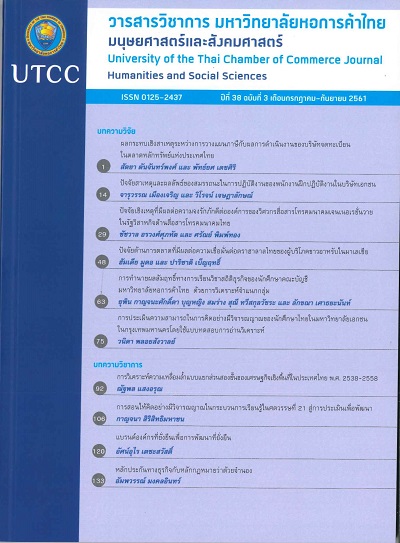sustainable Corporate Brand for Sustainable Development
Main Article Content
Abstract
Sustainable Development Goals, which was adopted at the 70th Session of the UN
General Assembly, reflects the on-going social, economic, and environmental issues in the world.
These are issues that threaten the well-being of the people nowadays and in the future. As a result,
most countries’ development policies are now geared toward a concrete “Sustainable Development”
scheme. Business sector, as a part of the world society, has to be more responsible and
conscious of the society, and stepping in in order to enhance sustainability of the world.
The significant tool of the business sector to drive an organization toward sustainable development
is to create a “Sustainable Brand” under the concept of “Triple Bottom Line”, which means to
manage a brand with the focus on inclusively balancing of Economic, Social and Environment.
An organization with the capacity to develop sustainable brand will come with sustainability in
itself, a shared prosperity for stakeholders, and ability to nurture natural environment for the next
generation. In summary, this will gradually bring about sustainability of mankind at present and
in the future.
Article Details
ลิขสิทธิ์ของบทความ
ผลงานที่ได้รับการตีพิมพ์ถือเป็นลิขสิทธิ์ของมหาวิทยาลัยหอการค้าไทย ห้ามมิให้นำเนื้อหา ทัศนะ หรือข้อคิดเห็นใด ๆ ของผลงานไปทำซ้ำ ดัดแปลง หรือเผยแพร่ ไม่ว่าทั้งหมดหรือบางส่วนโดยไม่ได้รับอนุญาตเป็นลายลักษณ์อักษรจากมหาวิทยาลัยหอการค้าไทยก่อน
References
Keller, K. L. (2001). Building customer-based brand equity: A blueprint for creating strong brands. Retrieved March 2, 2017, from https://mktg.unisvishtov.bg/ivm/resources/CustomerBasedbrandEquityModel.pdf
Kotler, P., & Keller, K. L. (2016). Marketing management (15th ed.). Boston, MA: Pearson.L.P.N. Development Public Company Limited. (2015). 6 green LPN sustainable development report 2015. Retrieved October 12, 2016, from https://www.lpn.co.th/download/Annual_Report_2015_2.pdf (in Thai).
Management System Certification Institute, Strategic Management. (2010). Triple bottom line. MASCInsight, 10(30), 8-9. (in Thai).
Thailand CSR transforming activities into business strategy, 2015-2016. SM, 15(165), 44-45. (in Thai).
Thaipat Institute. (2012). What is CSR?. Retrieved October 12, 2016, from https://www.thaicsr.com/ 2006/03/blog-post_20.html (in Thai).
United Nations, Division for Sustainable Development. (2015). Sustainable development goals: 17 goals to transform our world. Retrieved October 12, 2016, from https://www.un.org/sustainabledevelopment/sustainable-development-goals/
Wonglorsaichon, P. (2011). The effect of corporate social responsibility, corporate governance, and code of conduct on corporate return on operations of the companies listed in the Stock Exchange of Thailand. University of the Thai Chamber of Commerce Journal, 31(4), 112-122. (in Thai).
Wyman, O. (2016). Social innovation: A guide to achieving corporate and societal value. Retrieved January 10, 2017, from https://www3.weforum.org/docs/WEF_Social_Innovation_Guide.pdf


